Hi everyone! I wanted to share a quick little science experiment you can do right at home! We’re learning all about plants right now, and so we did this cute experiment to show the kiddos how the stem of the flower pulls up water and nutrients to feed the flower.
Plants have roots which absorb water from the soil. The water travels through the roots and up the stem and into the leaves. The leaves gather sunlight, then use the sunlight, carbon dioxide, and water to make food for the plant in a process called photosynthesis. Cut flowers don’t have roots, but the water still moves up the stems and into the leaves giving a nice visual to how the process works.
What you will need:
- White Daisies or Carnations (However many you’d like to use, we did four)
- Glass Mason Jars
- Food Coloring or liquid watercolors
(We used food coloring, but I think the liquid water colors give a brighter end result.)
Experimentation Time!
First we filled our mason jars about half way with water. Then added one color of food coloring to each jar, make sure to add enough coloring to make your water quite saturated with color.
In the photo below, the third one over looks like light blue, but it’s actually purple. I didn’t put enough coloring in so I’ll have to go back and add some more so it works properly.
Next we cut the stems of our daisies with a diagonal slant to help the stem absorb more fluid, then placed them in the water.
Then the kids all filled out our Science Experiment Form to predict what would happen with the flowers.
Finally we waited…and surprisingly the flowers started changing color within about an hour. Actually the red one started to show up on the leaves first, then the blue next. The purple and green never did show up that well, so I think the stronger colored water definitely worked best.
Below you can see the blue starting to show up on the tips of this flower after about 45 minutes:
And here you can definitely see the red starting to streak across the petals of the flower after just about an hour:
By the end of the day the color was definitely visible in varying degrees with the red and blue showing the best. This is a great hands-on science experiment to show how essential roots and stems are to plant growth.
Have some fun kids science experiment ideas? Make sure to leave a comment below!


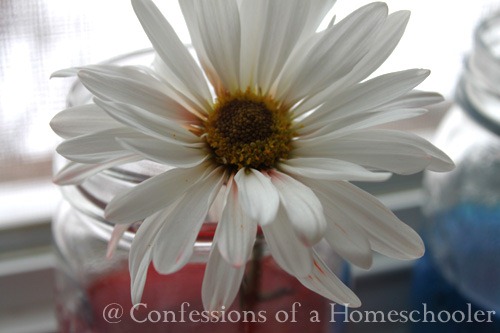
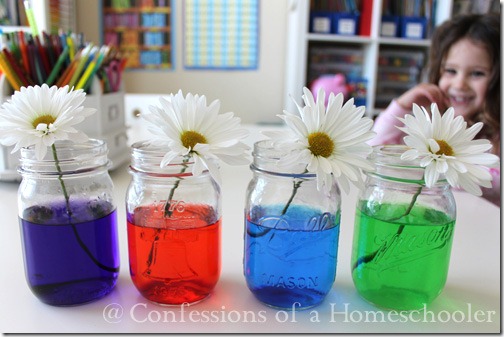
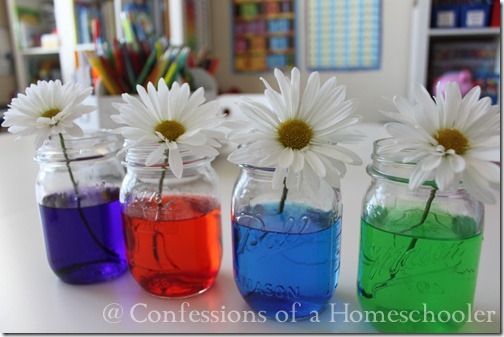
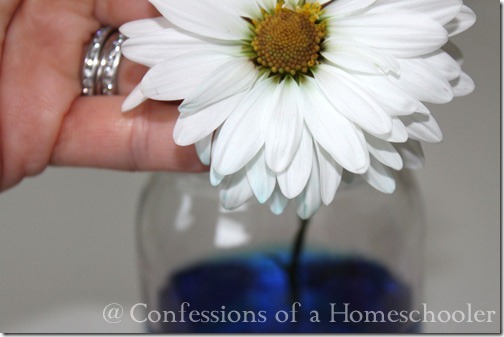
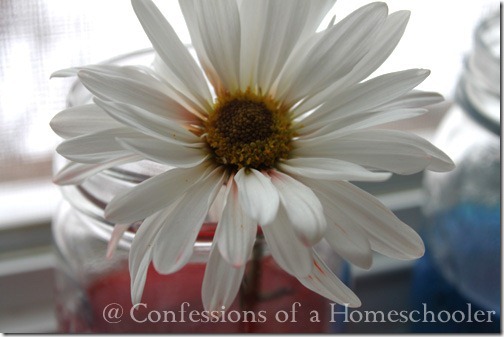
I’ve never tried it with daisies! That’s way nicer than celery. Taking notes for our spring activities. Thanks!
We do this experiment with Queen Anne’s Lace flowers every summer. They work really well too. Love it! 🙂
I cannot wait to do this with my daughter! I have been seeing it floating around the web for a while, but wanted to wait until she was old enough to sort of grasp the idea! Now if I can ever remember to get some daisies at the store. Daisies are one of my favorite flowers, so it will be a great experiment! Thanks for sharing! I have added it to our list of upcoming activities. 🙂
I love this experiment. Using celery is fun too.
I have a science project sunday on my blog. Elementary based projects every week!
We’ve done this with celery, but this would be so much more fun.
My 5 year old and I did this same experiment last summer with some daisies growing in our field. We did all the same colors as you plus yellow. It didn’t take long before the flowers started to show some color. By the next day the petals on the red flower were all wilted and curled up and the purple flower wasn’t much better (we obviously mixed blue and red food coloring to make purple). I’ve heard before that the artificial red food coloring is the worst one for us and after seeing what it did to the flowers it makes me wonder what it is doing to our bodies. The blue flower was spotty but the yellow and green flowers were just as pretty and happy as could be. In general I try to steer clear of artificial coloring and flavorings in our food and it was a fun experiment to see how the flowers reacted.
I just thought I’d share the results of our experiment and see if you found the same results with your red and purple flowers.
Blessings,
Darcy
Hi Erica, I purchased your printables some time back. Need to email you re. something but the ‘contact me’ button is unable to load. Would appreciate if you can drop me an email instead. Thanks!
Hi Erica! What a cool idea. I have heard of this experiment before, but never tried it. I honestly wasn’t even sure if it worked! I definitely want to try this with my kids. Have you done it with both daisies & carnations? If so, is there one that works better than the other?
I wonder if this could be done with colored flowers as well to show the change of color. Like red water with a yellow flower would turn the flower orange. It would be a science of mixing colors. I wonder if that would work? Thank you for the experiment!!!
That’d be an interesting way to illustrate mixing colors, wouldn’t it? For example red + yellow = orange, etc. I wonder if it would work…
Hello Erica –
My daughter (4 years old) and I just did this activity last week with white carnations and the results were fantastic! It was exciting to then see your post and helped remind me that homeschooling families really are connected.
Thanks for your dedication to this blog!